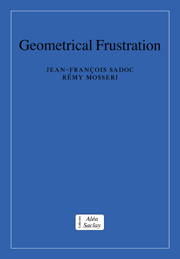Book contents
- Frontmatter
- Contents
- Preface
- 1 Introduction to geometrical frustration
- 2 Ideal models
- 3 Finite structures
- 4 Decurving and disclinations
- 5 Hierarchical polytopes
- 6 Some physical properties
- 7 Periodic structures with large cells
- 8 Quasiperiodic order and frustration
- A1 Spaces with constant curvature
- A2 Quaternions and related groups
- A3 Hopf fibration
- A4 Polytopes and honeycombs
- A5 Polytope {3, 3, 5}
- A6 Frank and Kasper coordination polyhedra
- A7 Quasiperiodic tilings: cut and projection
- A8 Differential geometry and parallel transport
- A9 Icosahedral quasicrystals and the E8 lattice
- Bibliography
- Index
A1 - Spaces with constant curvature
Published online by Cambridge University Press: 06 January 2010
- Frontmatter
- Contents
- Preface
- 1 Introduction to geometrical frustration
- 2 Ideal models
- 3 Finite structures
- 4 Decurving and disclinations
- 5 Hierarchical polytopes
- 6 Some physical properties
- 7 Periodic structures with large cells
- 8 Quasiperiodic order and frustration
- A1 Spaces with constant curvature
- A2 Quaternions and related groups
- A3 Hopf fibration
- A4 Polytopes and honeycombs
- A5 Polytope {3, 3, 5}
- A6 Frank and Kasper coordination polyhedra
- A7 Quasiperiodic tilings: cut and projection
- A8 Differential geometry and parallel transport
- A9 Icosahedral quasicrystals and the E8 lattice
- Bibliography
- Index
Summary
The three geometries
Spherical, Euclidean and hyperbolic geometries are the three types of homo-geneous geometries on which a two-dimensional manifold can be locally modelled. They have a constant Gaussian curvature which is positive in spherical space, null in Euclidean space and negative in hyperbolic space. In three dimensions these three geometries have an analogue, but there are five other homogeneous geometries (Thurston 1982, Scott 1983). In this section, we briefly present Euclidean and hyperbolic geometries, while the next section is devoted to spherical spaces. Section A1.3 is concerned with the more exotic cylindrical spaces and §A1.4 presents the different notions of curvature.
Euclidean geometry
Two- and three-dimensional Euclidean spaces do not require any long description. The main transformations which let the space be globally invariant are translations (which let no points be invariant), rotations (with one point – in two dimensions – and one line – in three dimensions – kept invariant) and mirror inversion (with one line – in two dimensions – and one plane – in three dimensions – kept invariant). Note that any rotation can be viewed as the combination of two mirror inversions, property which will be illustrated later with the groups generated by reflections, like in a kaleidoscope (appendix A4).
Hyperbolic geometry
Hyperbolic geometry differs from the Euclidean geometry by the basic axiom concerning parallelism. Now ‘through a point not on a line, there can be more than one line parallel to the given line’. This is quite unusual and we shall now give a quick description of what has also been called the Lobachevski–Bolyai geometry, with reference to its two independent discoverers.
- Type
- Chapter
- Information
- Geometrical Frustration , pp. 214 - 223Publisher: Cambridge University PressPrint publication year: 1999



